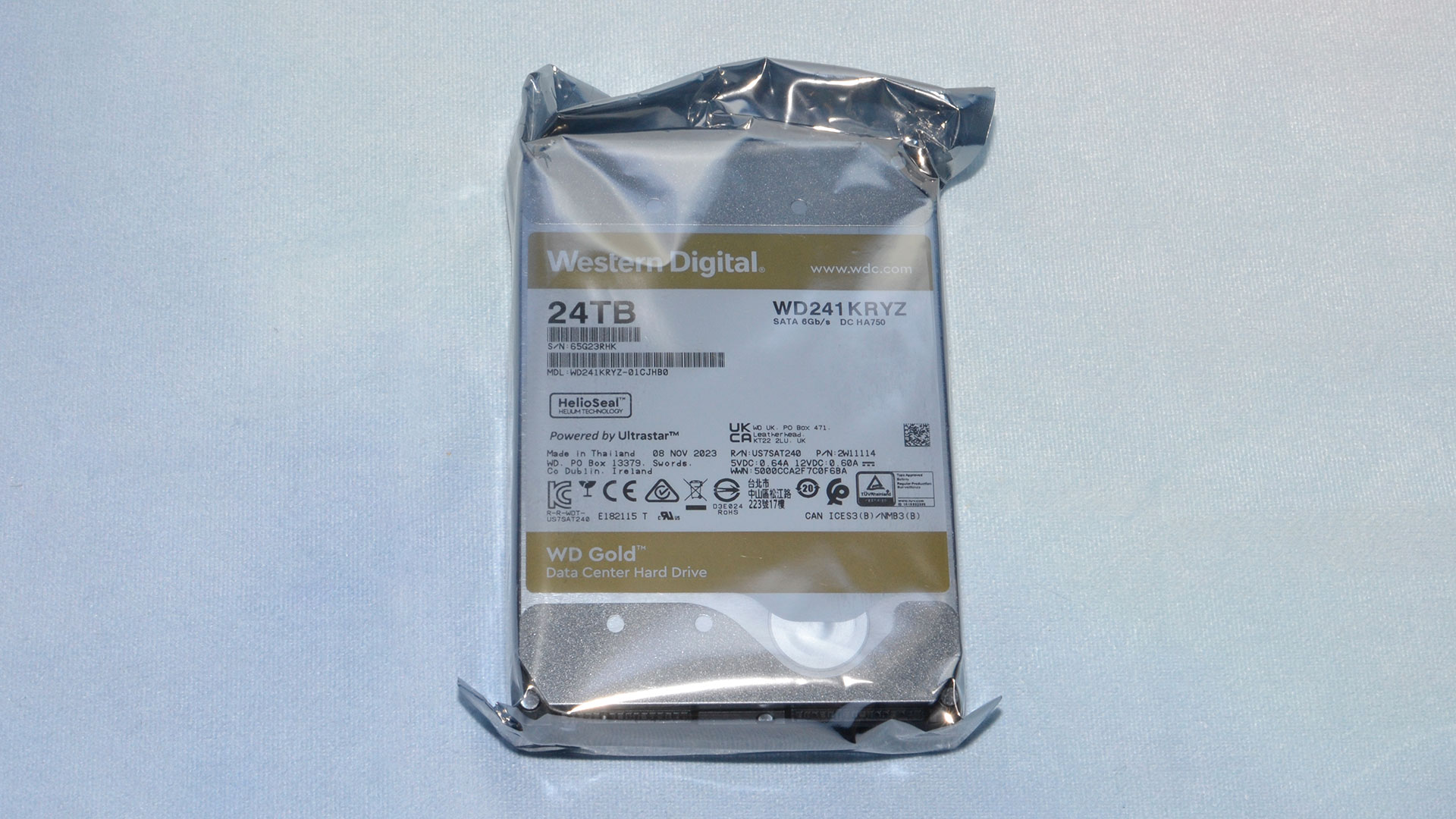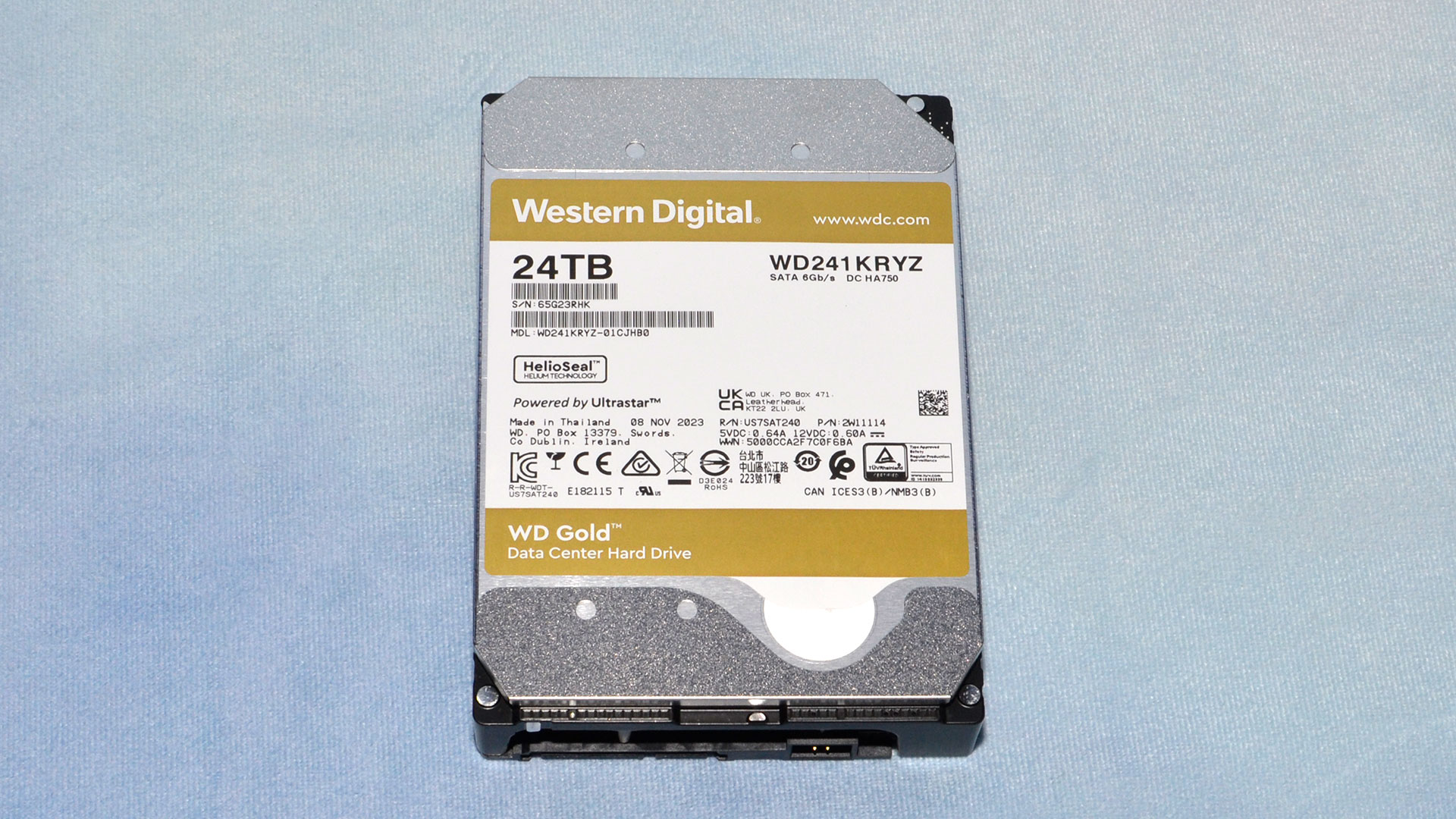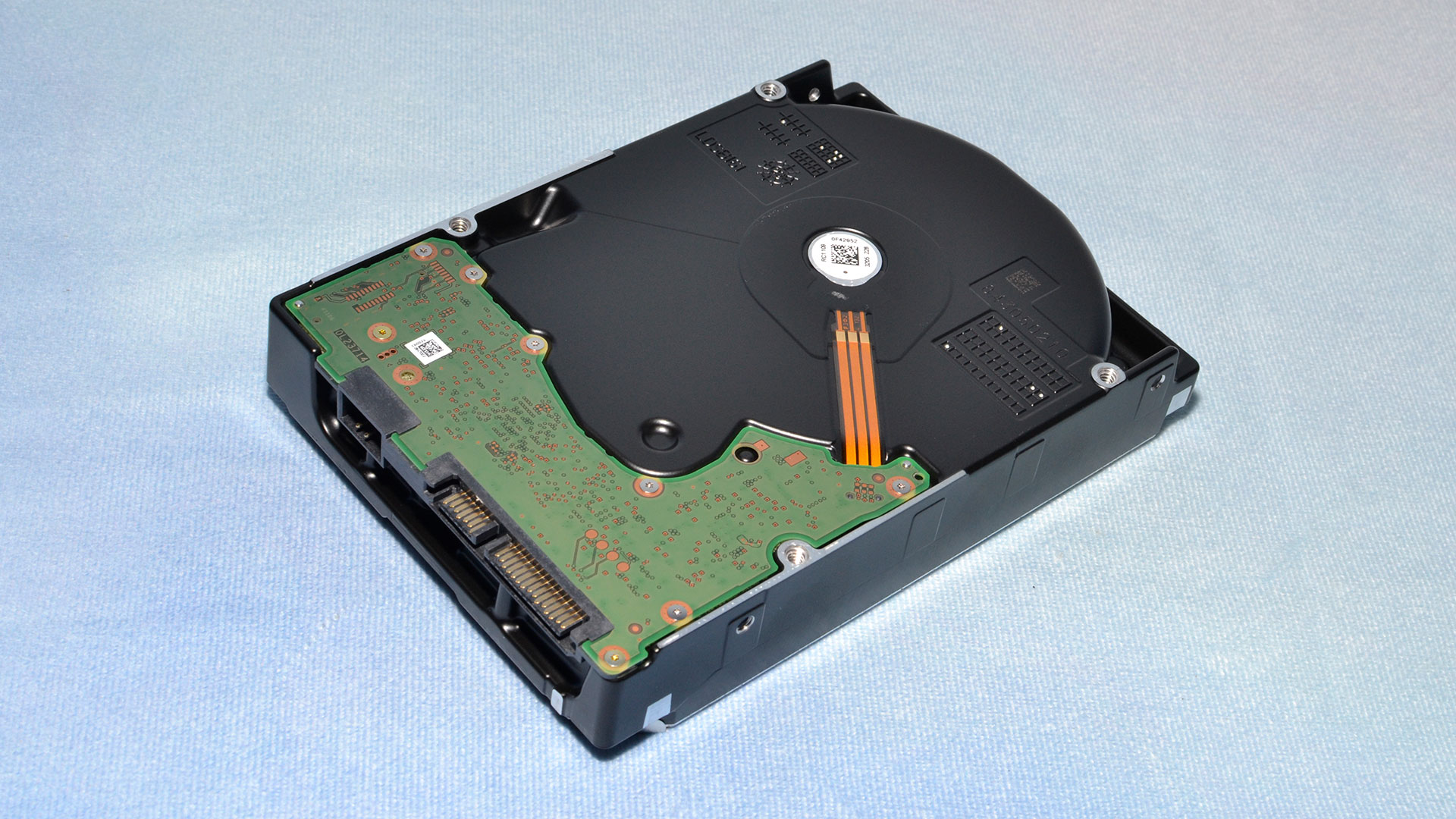Tom's Hardware Verdict
The WD Gold 24TB HDD brings no surprises, providing satisfactory performance for mechanical storage. It’s pricey but includes unique features thanks to the OptiNAND and ArmorCache technologies.
Pros
- +
High capacity
- +
OptiNAND and ArmorCache technology
Cons
- -
Pricing
Why you can trust Tom's Hardware
The WD Gold 24TB comes as the largest capacity hard drive currently available — other 24TB drives exist, but nothing larger can be purchased. It competes with the best hard drives primarily by offering more storage, but at a higher cost per GB. Western Digital has been around for decades in the storage world, and its color naming scheme is simple and easy to understand. The Gold drives represent its most performant line of HDDs and are intended for enterprise use.
Like its Seagate competitor, there’s some blurring across models such that differences are often fairly superficial. We even reviewed the Exos X20 and IronWolf Pro HDDs together in the past. While WD’s Gold line does share the flash-based OptiNAND technology with its Red Pro NAS line of HDDs, it has a unique feature to help it stand out: ArmorCache.
We discussed this technology in our WD Gold 22TB review and not a whole lot has changed with the 24TB drive. There are some minor performance differences but, on the whole, this drive is about getting the highest density of storage possible. OptiNAND helps with that, but there are side benefits for certain workloads as well, as addressed in our WD Red Pro review. You can get 24TB in other drives, like the WD Red Pro 24TB, Seagate IronWolf Pro 24TB, Seagate Exos X24 24TB, Seagate Skyhawk AI 24TB, or WD Ultrastar DC 24TB, but this is the first 24TB drive we've received for review. The primary attraction with the WD Gold is its ArmorCache technology. If you can make do with slightly lower storage density, though, the 22TB also has this feature at a lower cost.
Who would want ArmorCache? Someone who needs data protection without losing performance. In an environment that can use write caching, the Gold can safely write data out on power loss. In a stricter environment where write caching is denied, the Gold can maintain performance by leveraging the benefits of its flash. This has niche use outside of enterprise, but for diehards who want these benefits, the Gold is the only way to go. Luckily, its traditional HDD performance isn’t terrible, either; let’s take a look.
WD Gold Specifications
| Product | WD Gold | WD Red Pro | Seagate IronWolf Pro | Seagate Exos X24 | Seagate SkyHawk AI | Header Cell - Column 6 |
|---|---|---|---|---|---|---|
| Capacity | 24TB | 24TB | 24TB | 24TB | 24TB | Row 0 - Cell 6 |
| Model # | WD241KRYZ | WD240KFGX | ST24000NT002 | ST24000NM001H/2H | ST4000VE002 | Row 1 - Cell 6 |
| Pricing | $595.36 | $569.99 | $429.99 | $479.99 | $439.99 | Row 2 - Cell 6 |
| Cost per TB | $24.81 | $23.75 | $17.92 | $20.00 | $18.33 | Row 3 - Cell 6 |
| Interface | SATA 6 Gb/s | SATA 6 Gb/s | SATA 6 Gb/s | SATA 6 Gb/s | SATA 6 Gb/s | Row 4 - Cell 6 |
| Form Factor | 3.5" | 3.5" | 3.5" | 3.5" | 3.5" | Row 5 - Cell 6 |
| Technology | CMR | CMR | CMR | CMR | CMR | Row 6 - Cell 6 |
| RPM | 7,200 | 7,200 | 7,200 | 7,200 | 7,200 | Row 7 - Cell 6 |
| Sustained Transfer Rate | Up to 298 MB/s | Up to 287 MB/s | Up to 285 MB/s | Up to 285 MB/s | Up to 285 MB/s | Row 8 - Cell 6 |
| Cache | 512MB | 512MB | 512MB | 512MB | 512MB | Row 9 - Cell 6 |
| Operating Power | 6.8W | 6.4W | 6.3W | 6.3W | 6.3W | Row 10 - Cell 6 |
| Noise | 32 dBA | 32 dBA | 26 dBA | N/A | N/A | Row 11 - Cell 6 |
| Workload Rate Limit | 550 TB/yr | 550 TB/yr | 550 TB/yr | 550 TB/yr | 550 TB/yr | Row 12 - Cell 6 |
| MTBF | 2.5M hours | 2.5M hours | 2.5M hours | 2.5M hours | 2.5M hours | Row 13 - Cell 6 |
| Warranty | 5-Year | 5-Year | 5-Year | 5-Year | 5-Year | Row 14 - Cell 6 |
| Row 15 - Cell 0 | Row 15 - Cell 1 | Row 15 - Cell 2 | Row 15 - Cell 3 | Row 15 - Cell 4 | Row 15 - Cell 5 | Row 15 - Cell 6 |
The 24TB WD Gold is very similar to the 22TB model that we reviewed late last year. The capacity is higher, sure, but so is the price, closing in on $600 while the 22TB has currently fallen to $459.99. However, there are cases where you need every TB possible in the same space, and that’s what you are paying a premium for with this model. Capacities continue to slowly creep up, and new technologies on the roadmap with 24TB currently being the retail height.
The other differences are minor. The 24TB model goes from 291 MB/s to 298 MB/s for the maximum sustained transfer rate, a small bump. It’s still using a 10-platter solution with the side benefit that it’s also more power-efficient, operating at 6.8W instead of 7.1W. Otherwise, the warranty is the same, comparable to its direct peers at five years in length with a 550 TB/year workload limit and a 2.5 million hour MTBF.
WD Gold Software and Accessories
WD offers two important downloads: the Western Digital Dashboard and Acronis True Image for Western Digital. The Western Digital Dashboard is a powerful SSD/HDD toolbox for checking drive health information, grabbing firmware updates, and more. For imaging and cloning needs, the OEM Acronis True Image can assist you in backing up data and in other tasks. Note that cloning a full 20TB drive would require roughly a full day of continuous work, give or take.
WD Gold A Closer Look



If you’ve seen one hard drive, you’ve seen them all. The gold label lets us know that this drive is intended for enterprise use, in comparison to the WD Red Pro 24TB that's made for NAS use. The main power source, which when rated at 12V and 0.60A comes out to 7.2W, matches our expectations. There are no surprises here.
Beyond the SATA connectors for data and power, there’s a two-pin connection that should reduce the drive to 3 Gbps SATA operation instead of the default 6 Gbps. Internally, the drive is similar to others but stands out with the presence of iNAND for the OptiNAND technology. This is required for metadata in order to achieve maximum drive capacity and also for additional features — notably ArmorCache, which is only available on the 22TB and 24TB WD Gold HDDs. If the amount of NAND available for caching remains static between these two, it’s possible there could be minor performance impacts for the 24TB SKU.
We've covered WD’s OptiNAND technology thoroughly in our WD Gold 22TB review, but as a short refresher, it’s WD’s way of keeping up in the capacity chase. Certain data can be written to flash memory instead of the HDD platters, and as this is metadata, performance is also improved due to the flash’s superior random access performance. The flash is also non-volatile and allows the drive to be run with or without a write cache while having power loss protection even with the volatile cache enabled, as data can be flushed in time. This capability is known as ArmorCache and only applies to the 22TB and 24TB Gold. It's the primary selling point in comparison to competing drives.
MORE: Best SSDs
MORE: Best Hard Drives
Get Tom's Hardware's best news and in-depth reviews, straight to your inbox.
MORE: Best SSD for the Steam Deck

Shane Downing is a Freelance Reviewer for Tom’s Hardware US, covering consumer storage hardware.
-
newtechldtech It is strange that we are stuck with 7200RPM drives for higher capacities for a long time... the research is focused on capacity and not IOPS for HDD 10K RPM and 15K RPM exist for a long time as well but no one is researching incresing the capacity of such drives.Reply -
kyzarvs Reply
Why fight a battle you can never win?newtechldtech said:It is strange that we are stuck with 7200RPM drives for higher capacities for a long time... the research is focused on capacity and not IOPS for HDD 10K RPM and 15K RPM exist for a long time as well but no one is researching incresing the capacity of such drives.
SSD's will always have the speed side sewn up, most spinners are 'fast enough' to be near-line storage and are usually deployed as part of a larger array. Power consumption / heat, capacity and maybe noise are the only real improvements to be made. -
theugly Is there a SAS version of it ? In professional environments this will be most likely the case.Reply -
newtechldtech Reply
10K and 15K drives are not discontinued ... they are ust not increasing their capacties.kyzarvs said:Why fight a battle you can never win?
SSD's will always have the speed side sewn up, most spinners are 'fast enough' to be near-line storage and are usually deployed as part of a larger array. Power consumption / heat, capacity and maybe noise are the only real improvements to be made. -
newtechldtech Reply
https://www.seagate.com/products/enterprise-drives/exos-x/x24/theugly said:Is there a SAS version of it ? In professional environments this will be most likely the case. -
Vanderlindemedia Replynewtechldtech said:It is strange that we are stuck with 7200RPM drives for higher capacities for a long time... the research is focused on capacity and not IOPS for HDD 10K RPM and 15K RPM exist for a long time as well but no one is researching incresing the capacity of such drives.
https://thessdguy.com/why-dont-hdds-spin-faster-than-15k-rpm/#:~:text=As%20the%20speed%20of%20an,the%20lifetime%20of%20the%20HDD.
Heat, and lifespan of HDD suffers from higher speeds.
At 15K RPM your kind of already at the limit of a platter & head. It's within 2 ms avg response time and going higher only ensures a greater risk of reliability issues.
Your better off building a traditional HDD with a spare NVME cache - this way it can accelerate or cache while the HDD writes with traditional speeds.
Or if the time is ripe, a super storage based on SSD. No noise, barely power and far better reliability. -
emike09 Still stuck at 512MB cache. Is this due to limiting the amount of data that needs to be written during a power out scenario? All my servers have backup power generation, and also run on UPS power and receive shutdown signals when there's only 6 minutes of backup power remaining. They all finish what they're writing and shut down within 1-2 minutes. Maybe there's another reason to stay at 512MB?Reply -
emike09 Reply
There's got to be a better reason that that. I'd be very willing to pay extra for a larger cache.USAFRet said:$$$ -
8086 Replynewtechldtech said:It is strange that we are stuck with 7200RPM drives for higher capacities for a long time... the research is focused on capacity and not IOPS for HDD 10K RPM and 15K RPM exist for a long time as well but no one is researching incresing the capacity of such drives.
Also those 15K rpm drives tended to have smaller capacities that were similar to SSDs when SSDs were first introduced, making 10k and 15k irrelevant. The WD Raptor was more expensive than many 1tb SSDs when the 1tb raptor was still a thing.kyzarvs said:Why fight a battle you can never win?
SSD's will always have the speed side sewn up, most spinners are 'fast enough' to be near-line storage and are usually deployed as part of a larger array. Power consumption / heat, capacity and maybe noise are the only real improvements to be made.
